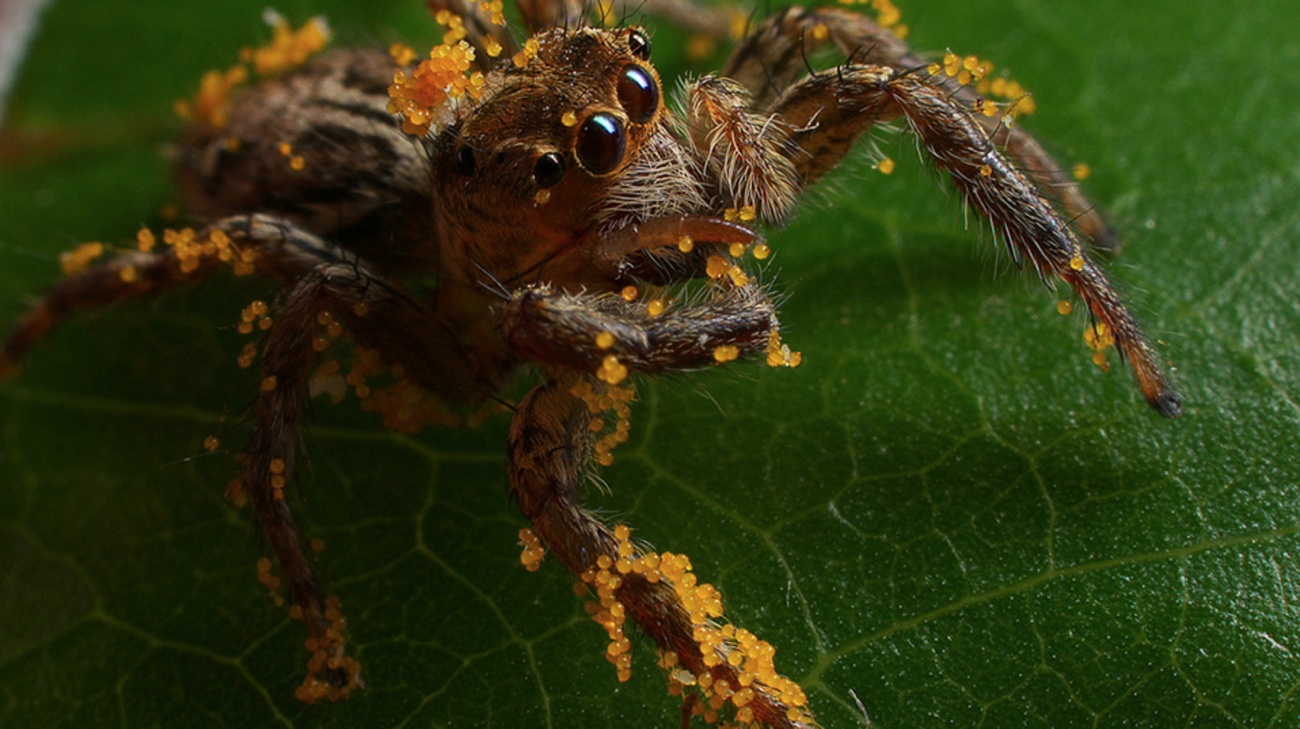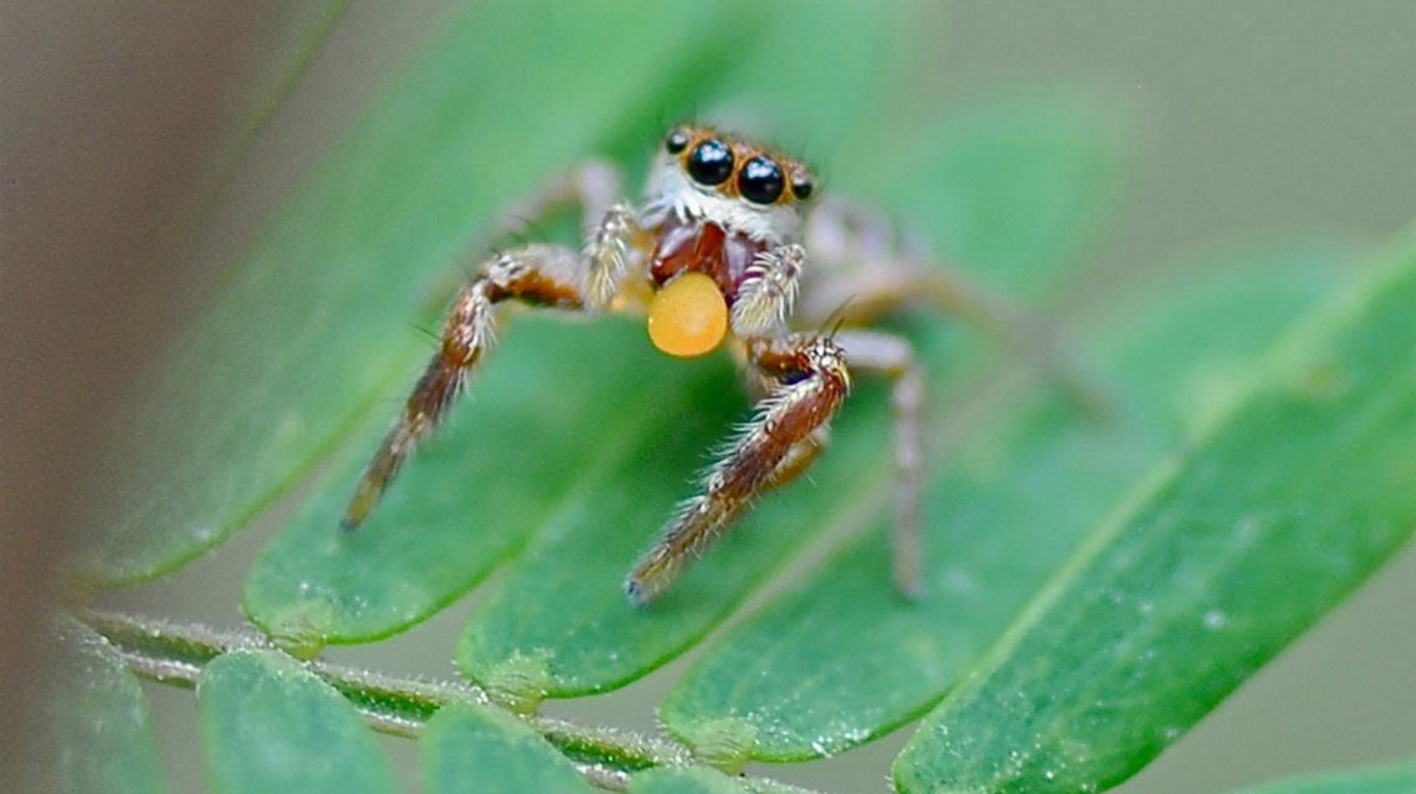These Spiders Like Some Greens with Their Insects

Spiders are known as clever predators, trapping and stalking their insect prey. But many species round out their diets with a little roughage.
There are at least 95 recorded instances of spiders eating plant products, according to a new review in the Journal of Arachnology. Spiders chow down on everything from nectar to sap to small fruiting bodies, wrote the study's leader, Martin Nyffeler, a research fellow in conservation biology at the University of Basel in Switzerland, and colleagues.
"Such a large diversity of plant types, plant taxa and plant materials being used as food by spiders is novel," Nyffeler told Live Science.
Even the most plant-loving spiders can't survive on a vegetarian diet alone, the researchers wrote, but spiders might be more resilient in times of food shortages if they eat plant food as well as prey. [See Photos of Amazing Plant-Eating Spiders from Around the World]
Plant food
About 60 percent of reported incidents of spiders eating plants have been jumping spiders (Salticidae), the largest family of spiders. These spiders live all over the world, and their plant-eating behavior has been observed on every continent except for Antarctica (where the spiders don't live) and Europe (where they live but haven't shown their habit of eating leafy greens). In about 75 percent of reported cases, spiders were observed eating nectar, and field tests of spiders have found that 20 percent to 30 percent have fructose in their guts — an ingredient in nectar — the researchers wrote.
For some jumping spiders, getting nectar is a sticky business, Nyffeler wrote in another study published March 6 in the journal Peckhamia. Ants also eat nectar, so spiders have to scurry in when ants aren't present in order to get nectar without a battle. They may also have to outrun or outjump ants if challenged, Nyffeler said. One genus, Peckhamia, even mimics ant behavior to sneak in for a sweet treat.
Sign up for the Live Science daily newsletter now
Get the world’s most fascinating discoveries delivered straight to your inbox.
Nectar is only one portion of the potential spider diet, though. Some spiders bite into leaves to feed on plant sap. The South American spider Anelosimus rupununi has been seen biting into mango leaves in Venezuela to suck the sap, for example. Spiders even eat the solid parts of the plants — though they have to inject small pieces with digestive fluids to liquefy them, just as they do with insects. In particular, a colorful jumping spider from Central America, called Bagheera kiplingi, eats almost exclusively Beltian bodies, which are sugar-rich nubs that grow on acacia plants.

Even weirder, some spiders feed on honeydew, which is a sugary liquid secreted by insects such as aphids that are also feeding on plants. Two species of jumping spiders, Myrmarachne foenisex and Myrmarachne melanotarsa, have been seen "milking" honeydew from insects called coccids. [Check Out Incredible Photos of Peacock Spiders]
Spiders seem to have all the enzymes they need to break down plant material, the researchers wrote, except for exinase, which breaks down the outer covering of pollen. But some spiders have been seen eating pollen, perhaps by piercing its outer shell. Spiders may also consume pollen, seeds and spores that accidentally get captured in their webs, the researchers wrote.
A balanced diet
About 80 percent of spider plant-eating occurs in warmer regions of the world, perhaps because plants secrete more nectar in warmer spots, Nyffeler and his colleagues wrote. They found evidence of more than 60 plant-eating spider species, but many more species may do the same, they added.
Most spiders cannot survive on plants alone, Nyffeler said. In lab studies, scientists have fed spiders vegetarian diets, like pollen or nectar alone, and have found that the spiders fail to molt or they have stunted growth. A possible exception is the largely herbivorous species B. kiplingi, Nyffeler said. But one laboratory study found that when B. kiplingi spiders were fed only plant matter, they died after a few weeks, too.
Nevertheless, plants may be an important part of the spider diet, Nyffeler said.
"The ability of spiders to derive nutrients from plant materials is broadening the food base of these animals; this might be one of several survival mechanisms helping spiders to stay alive for a while during periods when insect prey is scarce," he wrote in an email to Live Science. "Furthermore, enriching the spiders' diets with plant materials leads to a more diverse diet, a process considered to be advantageous from a nutritional point of view, since diet mixing is optimizing a balanced nutrient intake."
More studies need to be done to understand how different categories of plant food contribute to spider diets, how spiders digest plant foods and how frequent plant-eating is under natural conditions, Nyffeler said.
Follow Stephanie Pappas on Twitter and Google+. Follow us @livescience, Facebook & Google+. Original article on Live Science.

Stephanie Pappas is a contributing writer for Live Science, covering topics ranging from geoscience to archaeology to the human brain and behavior. She was previously a senior writer for Live Science but is now a freelancer based in Denver, Colorado, and regularly contributes to Scientific American and The Monitor, the monthly magazine of the American Psychological Association. Stephanie received a bachelor's degree in psychology from the University of South Carolina and a graduate certificate in science communication from the University of California, Santa Cruz.









